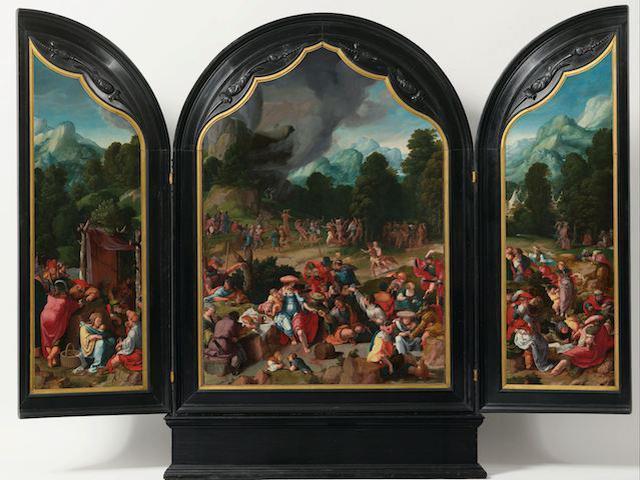Worship of the Golden Calf

The painting "Worship of the Golden Calf" by Lucas Van Leyden is a striking representation of a biblical narrative that serves as a cautionary tale against idolatry and moral decadence. Created in the 16th century, this triptych masterpiece captures the moment when the Israelites, led astray by their own desires, betray God by worshipping a golden calf. The intricate details and symbolism woven into the artwork reveal the artist's deep understanding of religious themes and his commentary on the societal shifts of his time.
In the central panel of the triptych, the chaotic scene unfolds with the Israelites reveling in their disobedience, oblivious to the impending consequences of their actions. Moses, the revered leader of the Israelites, is depicted in the background, a solitary figure kneeling in despair as he witnesses the betrayal of his people. The tension between faith and temptation is palpable in the composition, as the figures engage in acts of revelry and indulgence, forsaking their devotion to God for fleeting pleasures.
The rich symbolism present in the painting adds layers of meaning to the narrative, inviting viewers to contemplate the deeper implications of the story. The woman offering a fruit to a man symbolizes the original sin of Adam and Eve, highlighting the recurring theme of temptation and its consequences. The vibrant colors and intricate details of the clothing and headdresses evoke a sense of opulence and excess, serving as a stark contrast to the solemnity of the biblical narrative being depicted.
As a reflection of the religious and cultural tensions of the time, "Worship of the Golden Calf" serves as a powerful reminder of the dangers of straying from one's faith and succumbing to worldly desires. The artist's skillful execution of the triptych format allows for a dynamic storytelling experience, drawing viewers into the narrative and prompting contemplation of their own beliefs and values. Through this masterful work of art, Lucas Van Leyden leaves a lasting impression on those who encounter the painting, challenging them to reflect on the timeless themes of faith, temptation, and the consequences of moral compromise.
© ChatGPT 3.5